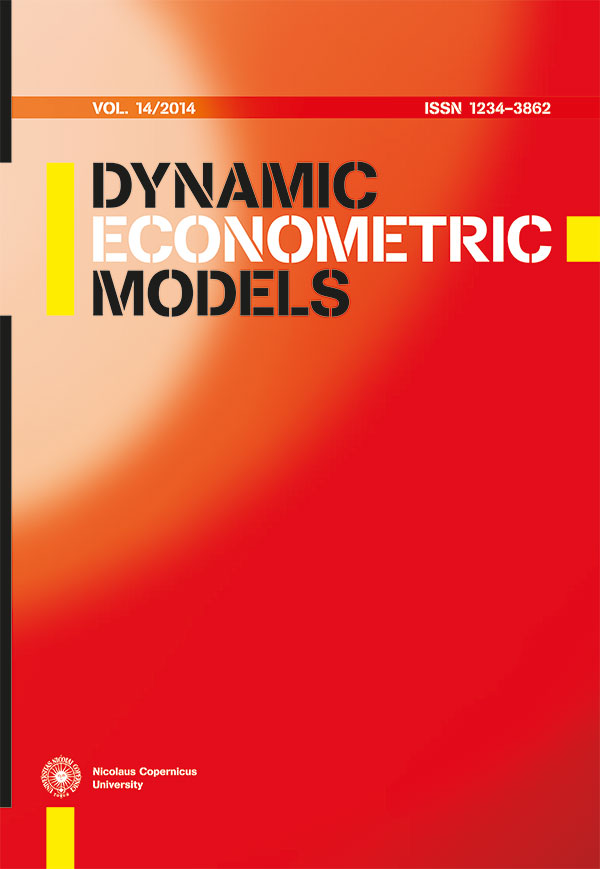Evaluating the Accuracy of Time-varying Beta. The Evidence from Poland
DOI:
https://doi.org/10.12775/DEM.2017.010Keywords
BEKK, DCC, Kalman filter, MGARCH, time-varying betaAbstract
This paper empirically investigates various approaches to model time-varying systematic risk on the Polish capital market. A plenty of methods is examined in the developed markets and the Kalman filter approach is usually indicated as the best method for estimation of time-varying beta. However, there exists a gap in the studies for the emerging markets. In the paper we apply weekly data of fifteen stocks listed on the Warsaw Stock Exchange from banking and informatics sector. The sample starts at the beginning of 2001 and ends in 2015 including the hectic crisis period. We estimate beta within few competing approaches: two MGARCH models, BEKK and DCC, unobserved component model, and static beta from linear regression. All beta estimates are compared in the securities market line framework. We find that unobserved component beta together with beta from DCC model have higher predictive accuracy than beta from BEKK model or static beta. The beta estimates are positively correlated within the industry and negatively correlated for stocks from different sectors. Finally, the prediction of beta coefficients are more accurate for stocks from banking sector than for IT companies.
References
Andersen, T. G., Bollerslev, T. (1998), Answering the Skeptics: Yes, Standard Volatility Models Do Provide Accurate Forecasts. International Economic Review, 39(4), 885–905.
Andersen, T. G., Bollerslev, T., Christoffersen, P., Diebold, F. X. (2007), Practical Volatility and Correlation Modeling for Financial Market Risk Management, Risks of Financial Institutions, 513–548, DOI: https://doi.org/10.3386/w11069.
Andersen, T. G., Bollerslev, T., Christoffersen, P. F., Diebold, F. X. (2006), Volatility and Correlation Forecasting. Handbook of Economic Forecasting, 1, DOI: https://doi.org/10.1016/S1574-0706(05)01015-3.
Andersen, T. G., Bollerslev, T., Diebold, F. X., Labys, P. (2001), The Distribution of Realized Exchange Rate Volatility, Journal of the American Statistical Association, 96, 42–55, DOI: https://doi.org/10.1198/016214501750332965.
Andersen, T. G., Bollerslev, T., Diebold, F. X., Wu, G. (2006), Realized Beta: Persistence and Predictability, Advances in Econometrics, 2(05), 1–39, DOI: https://doi.org/10.1016/S0731-9053(05)20020-8.
Andersen, T. G., Bollerslev, T., Meddahi, N. (2010), Realized Volatility Forecasting and Market Microstructure Noise, Journal of Econometrics, 160(1), 220–234, DOI: https://doi.org/10.1016/j.jeconom.2010.03.032.
Armstrong, B. J. S., Collopy, F. (1992), Error Measures For Generalizing About Forecasting Methods: Empirical Comparisons By J. Scott Armstrong and Fred Collopy Reprinted with permission form, International Journal of Forecasting, 8(1), 69–80, DOI: https://doi.org/10.1016/0169-2070(92)90008-W.
Będowska-Sójka Barbara. (2015), Unemployment Rate Forecasts: Evidence from the Baltic States, Eastern European Economics, 53(1), 57–67, DOI: https://doi.org/10.1080/00128775.2015.1033236.
Bollerslev, T., Engle, R. F., Nelson, D. B. (1994), ARCH Models. In Engle, R. F. and McFadden D. (Eds.), The Handbook of Econometrics, 4, 2959–3038), Elsevier Science, Amsterdam.
Brooks, R. D., Faff, R. W., McKenzie, M. D. (1998), Time-varying Beta Risk of Australian Industry Portfolios: A Comparison of Modeling Techniques, Australian Journal of Management, 23(1), 1–22.
Campbell, J. Y., Lo, A. W., MacKinlay, A. C. (1997), The Econometrics of Financial Markets, Princeton University Press, Chichester.
Choudhry, T., Wu, H. (2008), Forecasting Ability of GARCH vs Kalman Filter Method: Evidence from Daily UK Time-varying Beta, Journal of Forecasting, 27(8), 670–689, DOI: https://doi.org/10.1002/for.1096.
Dębski, W., Feder-Sempach, E., Świderski, B. (2014), Intervalling Effect On Estimating The Beta Parameter For The Largest Companies On The WSE, Folia Oeconomica Stetinensia, 14(2), 270–286, DOI: https://doi.org/10.1515/foli-2015-0018.
Dębski, W., Feder-Sempach, E., Świderski, B. (2016), Beta Stability Over Bull and Bear Market on the Warsaw Stock Exchange, Folia Oeconomica Stetinensia, 16(1), 75–92, DOI: https://doi.org/10.1515/foli-2016-0006.
Doornik, J. A., Hendry, D. F. (2006), Empirical Econometric Modelling using PcGive: Volume I, Timberlake Consultants Press, London.
Engle, R. (2002), Dynamic Conditional Correlation – a Simple Class of Multivariate Garch Models, Journal of Business and Economic Statistics, 20(3), 339–350, DOI: https://doi.org/10.1198/073500102288618487.
Engle, R. F., Kroner, K. F. (1995), Multivariate Simultaneous Generalized Arch, Econometric Theory, 11(1), 122–150.
Faff, R. W., Hillier, D., Hillier, J. (2000), Time Varying Beta Risk: An Analysis of Alternative Modelling Techniques, Journal of Business Finance & Accounting, 27(5–6), 523–554, DOI: https://doi.org/10.1111/1468-5957.00324.
FTSE. (2016), FTSE Country Classification.
Hajizadeh, E., Seifi, A., Fazel Zarandi, M. H., Turksen, I. B. (2012), A Hybrid Modeling Approach for Forecasting the Volatility of S&P 500 Index Return, Expert Systems with Applications, 39(1), 431–436, DOI: https://doi.org/10.1016/j.eswa.2011.07.033.
Harvey, D., Leybourne, S., Newbold, P. (1997), Testing the Equality of Prediction Mean Squared Errors, International Journal of Forecasting, 13(2), 281–291, DOI: https://doi.org/10.1016/S0169-2070(96)00719-4.
Huang, C. F., Litzenberger, R. H. (1988), Foundations for Financial Economics, North Holland, New York.
Jagannathan, R., Wang, Z. (1996), The Conditional CAPM and the Cross-Section of Expected Returns, Journal of Finance, 51(1), 3–53, DOI: https://doi.org/10.2307/2329301.
Koopman, S. J., Harvey, A. C., Doornik, J. A., Shephard, N. (2006), STAMP 7: Structural Time Series Analyser and Modeller and Predictor, Timberlake Consultants Press, London.
Kurach, R., Stelmach, J. (2014), Time-Varying Behaviour of Sector Beta Risk - the Case of Poland, Romanian Journal of Economic Forecasting, 17(1), 139–159.
Laurent, S. (2013), G@RCH 7: Estimating and Forecasting ARCH Models. Timberlake Consultants Press, London.
Lie, F., Brooks, R., Faff, R. (2000), Modelling the Equity Beta Risk of Australian Financial Sector Companies, Australian Economic Papers, 39(3), 301–311, DOI: https://doi.org/10.1111/1467-8454.00093.
Menchero, J. G., Nagy, Z., Singh, A. (2016), Evaluating the Accuracy of Beta Forecasts. The Journal of Portfolio Management, 84–93.
Oliver Wyman, World Federation of Exchanges (2016), Enhancing Liquidity in Emerging Market Exchanges.
Rockinger, M., Urga, G. (2001), A Time Varying Parameter Model to Test for Predictability and Integration in the Stock Markets of Transition Economies, Journal of Business & Economic Statistics, 19(1), 73–84, DOI: https://doi.org/10.1198/07350010152472634.
Wang, Y. H. (2009), Nonlinear Neural Network Forecasting Model for Stock Index Option Price: Hybrid GJR-GARCH approach, Expert Systems with Applications, 36(1), 564–570, DOI: https://doi.org/10.1016/j.eswa.2007.09.056.
Downloads
Published
How to Cite
Issue
Section
License
The journal provides an Open Access to its content based on the non-exclusive licence Creative Commons (CC BY-ND 4.0).
To enable the publisher to disseminate the author's work to the fullest extent, the author must agrees to the terms and conditions of the License Agreement with Nicolaus Copernicus University.
Stats
Number of views and downloads: 631
Number of citations: 0



